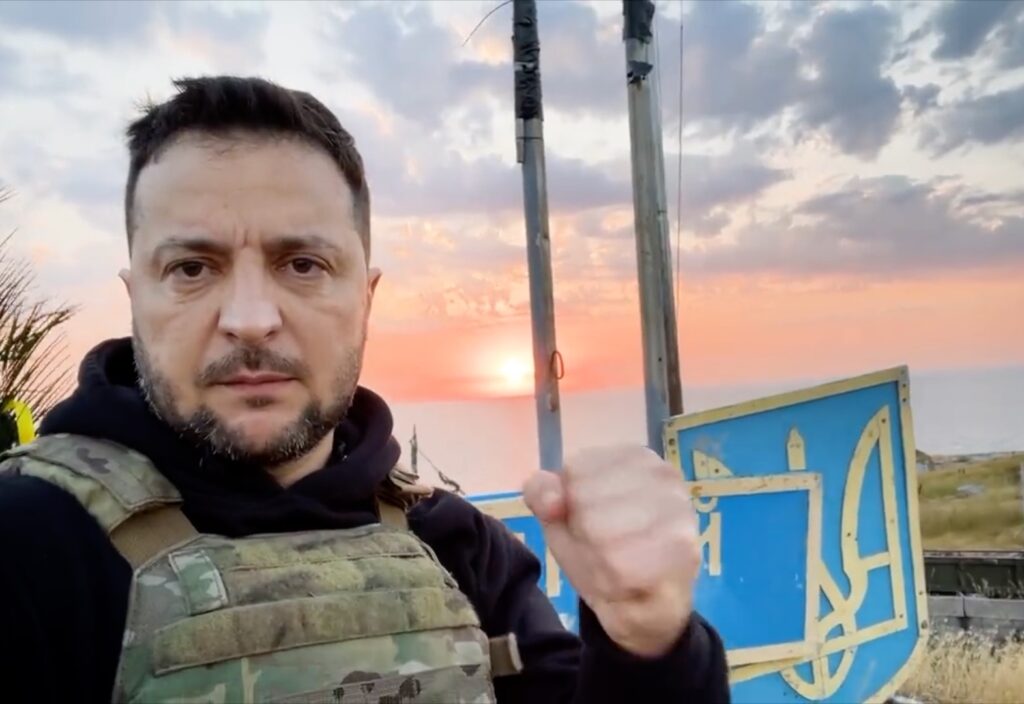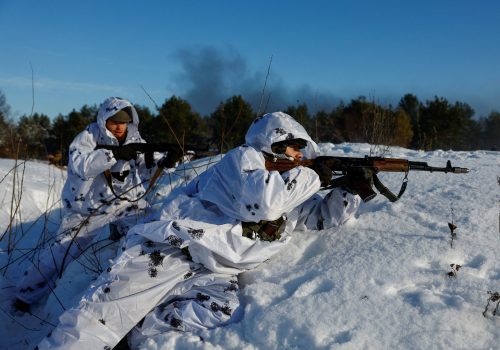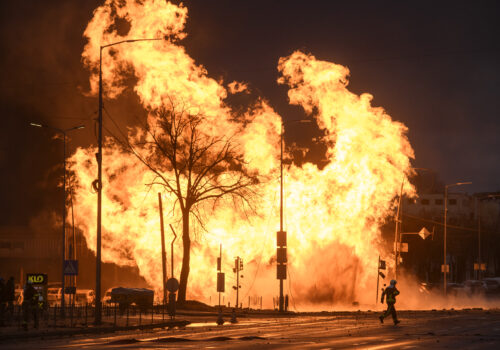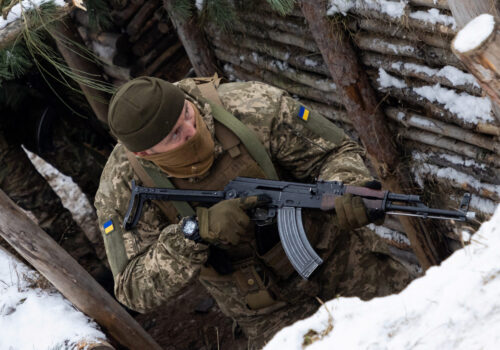There is no disguising the disquiet in today’s Ukraine as the country braces itself for what promises to be an exceptionally difficult year. The optimism of early 2023 has been replaced by a far gloomier outlook that reflects the failure of Ukraine’s much-hyped counteroffensive and mounting alarm over delays in vital military aid from the country’s international partners.
This is fueling fresh calls for a negotiated settlement, with advocates arguing that the war with Russia has now reached a stalemate. However, talk of an impasse may be premature. Although the 1000 kilometer front line of the conflict has barely moved for the past twelve months, events elsewhere indicate a military breakthrough could still be a realistic possibility.
While the international media has spent much of the past year firmly focused on the bloody but largely static battlefields of eastern and southern Ukraine, the most dynamic developments of the war in 2023 actually took place at sea. Despite having no warships of its own, Ukraine managed to force Putin’s fleet to retreat from Crimea and succeeded in breaking the Russian naval blockade of Ukraine’s Black Sea ports. This remarkable Ukrainian progress may now offer a blueprint for a more general victory over Russia.
Ukraine has been able to transform the balance of power in the Black Sea thanks to the skill, boldness, and ingenuity of the country’s military, together with ample supplies of Western weapons and the ability to use them without being hampered by restrictions based on misguided fears of a possible escalation. If applied to the wider Ukrainian war effort, this winning combination could pave the way for Russia’s eventual defeat.
Stay updated
As the world watches the Russian invasion of Ukraine unfold, UkraineAlert delivers the best Atlantic Council expert insight and analysis on Ukraine twice a week directly to your inbox.
On the eve of the full-scale invasion two years ago, Russian mastery of the Black Sea seemed all but assured. Ukraine was even more hopelessly outgunned at sea than on land, and appeared no match for the might of Russia’s Black Sea Fleet. Putin was so confident that he began the blockade of Ukraine’s Black Sea ports under the guise of naval exercises almost two weeks before the start of the land invasion.
The first significant naval engagement came in the initial hours of the invasion when the Russian Black Sea Fleet’s powerful flagship, the Moskva, approached Ukraine’s Snake Island and ordered the tiny garrison to surrender, only to be told: “Russian warship, go f*ck yourself.” This instantly iconic reply was rapidly embraced by Ukrainians as a symbol of national defiance and an unofficial slogan for the country’s entire war effort. It was soon appearing on billboards and bumper stickers, and even inspired an award-winning postage stamp.
During the early weeks of the invasion, residents of southern Ukraine’s Odesa Oblast were on high alert over possible amphibious landings, with Russian warships cruising menacingly along the horizon. However, these landings would never take place. Instead, in April 2022, Ukraine scored its first major success in the Battle of the Black Sea by sinking Russia’s flagship with domestically produced cruise missiles.
Two months later, Ukraine used a mix of artillery, air power, and drones to force a Russian withdrawal from the small but strategically important Snake Island. This was followed by the first Ukrainian drone attacks on port facilities and naval infrastructure in Russian-occupied Crimea.
As 2022 drew to a close, it was clear that the tide was beginning to turn at sea, with Russian naval dominance no longer a foregone conclusion. Even so, the scale of Ukraine’s subsequent achievements on the Black Sea front would surpass all expectations.
Britain’s May 2023 decision to supply Ukraine with Storm Shadow long-range cruise missiles set the stage for the spectacular progress that was to follow. In July, France followed suit with deliveries of its own SCALP cruise missiles. This dramatically enhanced Ukraine’s ability to strike targets in Crimea.
During the second half of the year, Ukraine bombed an array of Russian warships, logistics hubs, air defense systems, and command centers throughout the occupied peninsula. Highlights included a series of attacks in September that seriously damaged a Russian warship and submarine along with the headquarters of the Black Sea Fleet itself.
At sea, Ukraine deployed domestically produced naval drones to great effect, striking Russian shipping in Crimea and across the northern Black Sea. In August 2023, Ukraine signaled the range of its naval drone fleet with successful attacks on a Russian warship and oil tanker close to the Russian port of Novorossiysk on the eastern coast of the Black Sea, which serves as a major hub for Russian energy exports.
This campaign of missile and drone attacks eventually forced Russia’s Black Sea Fleet commanders to acknowledge that their position was no longer tenable. By early October, Russia had reportedly withdrawn the bulk of its remaining warships and submarines from Crimea to the relative safety of Russian ports.
Russia’s naval retreat allowed Ukraine to end the blockade of the country’s seaports and resume merchant shipping. An earlier grain agreement brokered by the UN in July 2022 had made it possible for Ukraine to export some agricultural produce, but these shipments were on unfavorable terms and subject to Russian interference. When Putin announced Russia’s withdrawal from the initiative in summer 2023 and threatened to target any ships sailing for Ukrainian ports, Ukraine felt confident enough to defy the Kremlin and declare a new “humanitarian corridor” for cargo vessels.
This new corridor has thrived, with food exports in December 2023 already surpassing the maximum monthly volume achieved during the UN-backed grain deal. The renewal of maritime trade has provided Ukraine with a vital economic lifeline and contributed to last year’s impressive GDP growth of approximately five percent.
Eurasia Center events

Ukraine’s remarkable gains in the Black Sea arena highlight what can be achieved when the country’s partners overcome their escalation phobia and provide Ukrainian commanders with sufficient weapons without imposing artificial restrictions on their use.
Ever since the start of Putin’s full-scale invasion, Western leaders have withheld key categories of weapons while limiting Ukraine’s ability to strike back at Russia due to concerns over Moscow’s possible response. This self-defeating approach was also initially applied to Crimea, even though the Russian-occupied peninsula is internationally recognized as part of Ukraine.
Ukrainian President Volodymyr Zelenskyy recently highlighted the damage done by the West’s obvious fear of escalation. Addressing the World Economic Forum in Davos, Zelenskyy recounted how Ukrainian officials constantly heard the same “don’t escalate” mantra from the country’s allies. “Every “don’t escalate” to us, sounded like “you will prevail” to Putin,” he noted. “Nothing has harmed our coalition more than this concept.”
There is no question that Putin has sought to exploit the West’s evident timidity. Throughout the invasion, he has employed threats and bluster to decrease the flow of weapons to Ukraine and determine where Ukraine can and cannot attack. Putin’s most powerful tool in this regard has been nuclear blackmail. On numerous occasions, he has hinted at a nuclear response if territory he regards as Russian is targeted. “I’m not bluffing,” he warned in September 2022.
While Western leaders have proven highly susceptible to Russian saber-rattling, Ukrainians have had no such qualms about calling Putin’s bluff and have done so repeatedly. On each occasion, it has soon become clear that the Russian dictator’s threats are about as credible as his promises.
Despite increasingly bold Ukrainian attacks on Crimean targets, Putin has failed to escalate in any meaningful way. Instead, when confronted by unfavorable new military realities in the Black Sea, the Russian fleet quietly withdrew. This makes a complete mockery of the crippling hesitancy displayed by much of the democratic world.
Ukraine’s strategic success in the Black Sea offers a number of important lessons for the future conduct of the war. It underlines the Ukrainian military’s ability to seamlessly integrate the latest Western weapons systems into their own offensive operations, while also confirming Russia’s inability to defend itself against this enhanced Ukrainian firepower.
By combining a limited number of cruise missiles provided by Britain and France with its own expanding drone capabilities, Ukraine has been able to destroy around 20 percent of Russia’s Black Sea Fleet and force the remaining warships to retreat. Additional weapons supplies could have a similarly profound impact on the battlefields of mainland Ukraine.
Perhaps most of all, Ukraine’s progress at sea confirms the emptiness of Russian threats and the utter folly of the West’s emphasis on avoiding escalation at all costs. Kremlin officials employ threatening language because they believe the West lacks resolve. So far, they have been proved correct.
For almost two years, Western leaders have allowed themselves to be intimidated by Russia. They have denied Ukraine the weapons needed to win the war for fear of provoking Putin. This disastrous approach has merely served to prolong hostilities and embolden the Kremlin. It should now be painfully clear that nothing is more likely to provoke Russian aggression than continued Western weakness.
In 2024, Ukraine’s partners must draw the logical conclusions from developments in the Black Sea and apply them to create a war-winning strategy. This means abandoning their own self-imposed red lines and finally providing Ukraine with the tools to finish the job. Western fear of Russian escalation is Putin’s secret weapon. It is high time he was disarmed.
Peter Dickinson is editor of the Atlantic Council’s UkraineAlert service.
Further reading
The views expressed in UkraineAlert are solely those of the authors and do not necessarily reflect the views of the Atlantic Council, its staff, or its supporters.

The Eurasia Center’s mission is to enhance transatlantic cooperation in promoting stability, democratic values and prosperity in Eurasia, from Eastern Europe and Turkey in the West to the Caucasus, Russia and Central Asia in the East.
Follow us on social media
and support our work
Image: Ukrainian President Volodymyr Zelenskyy visits Snake Island. Saturday July 8, 2023. (EYEPRESS via Reuters Connect)




